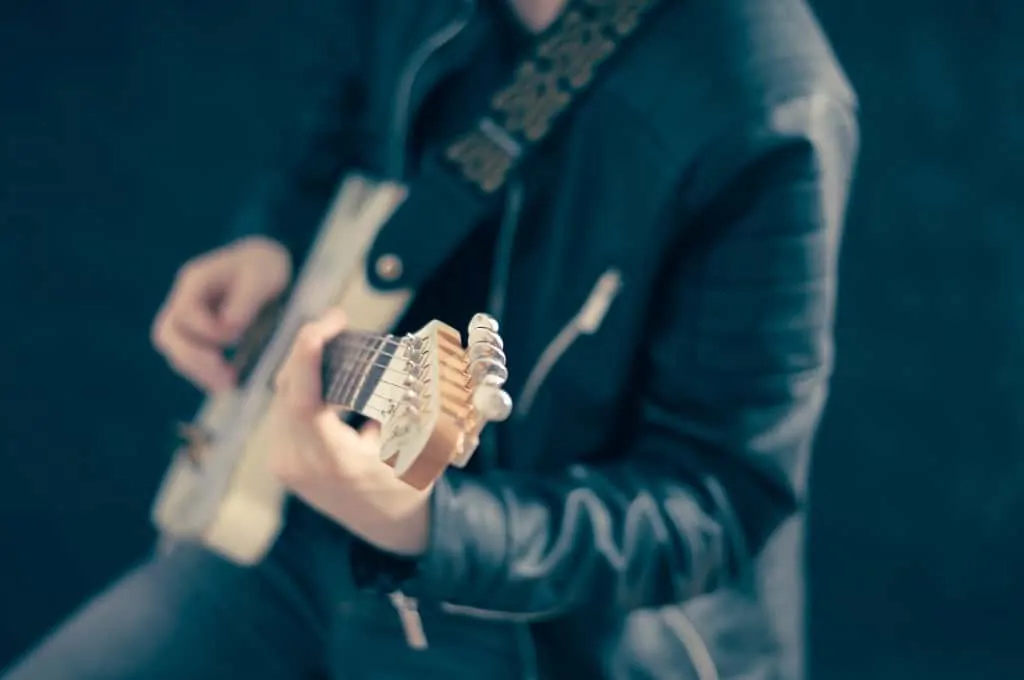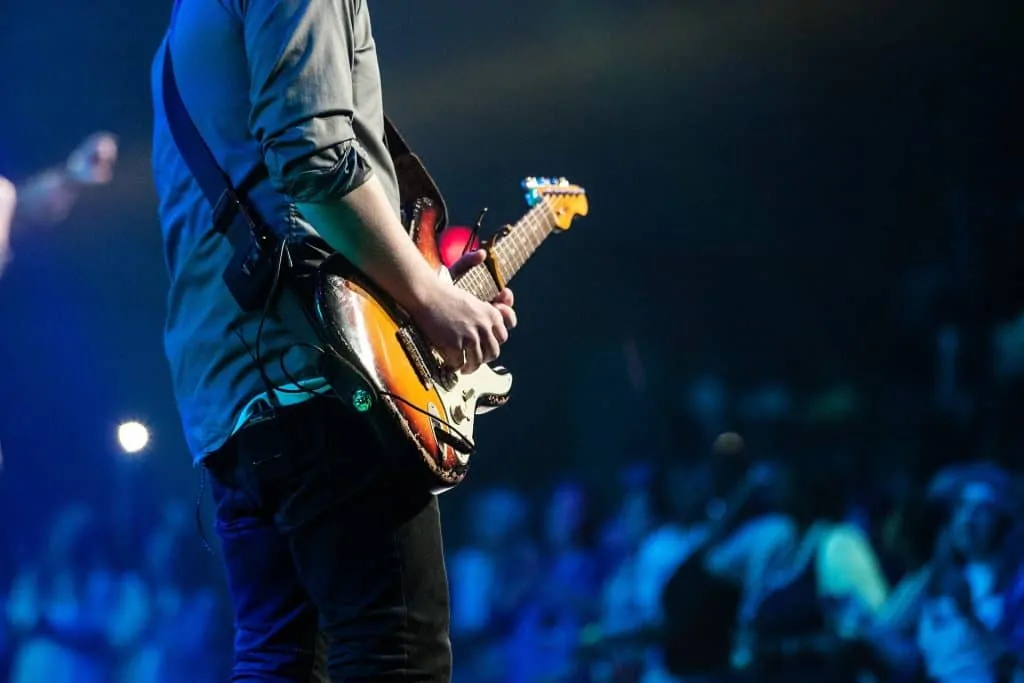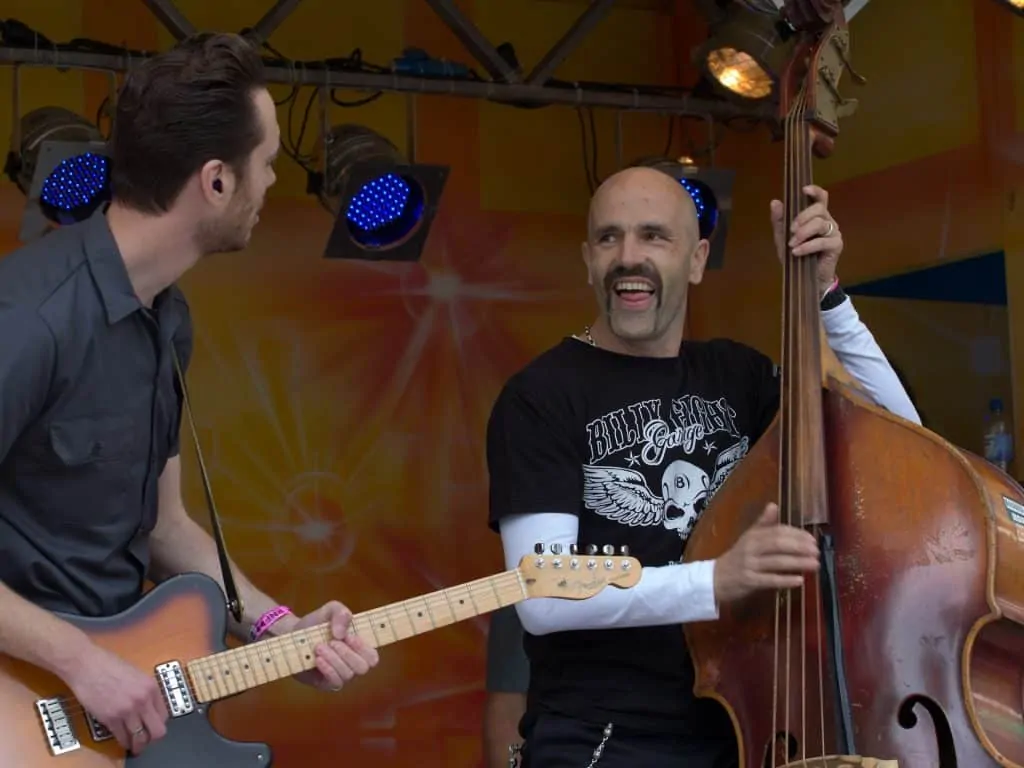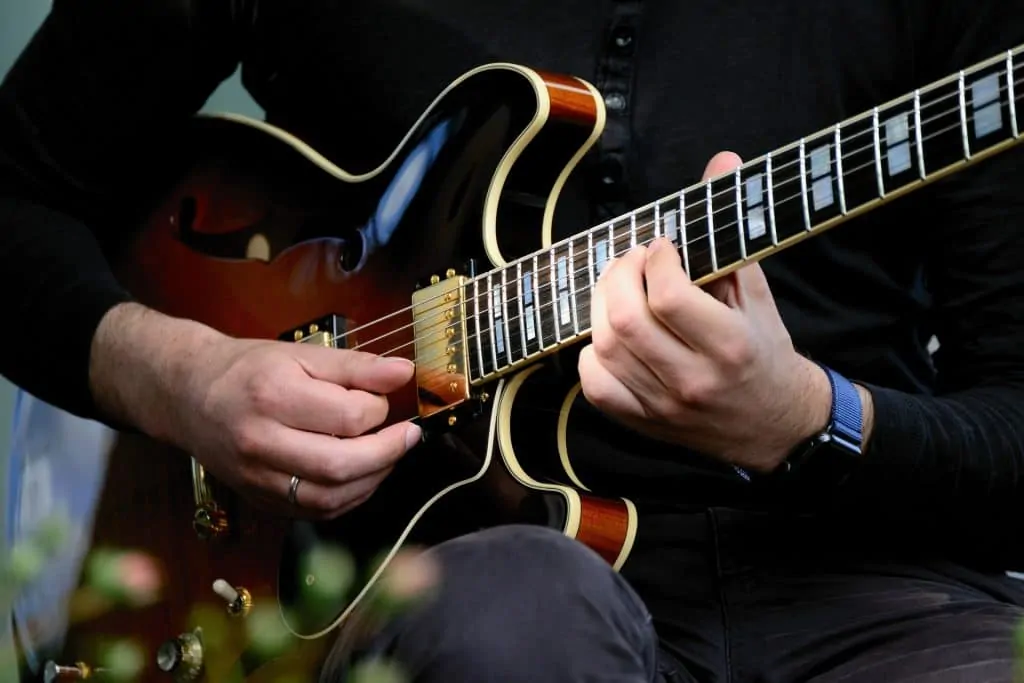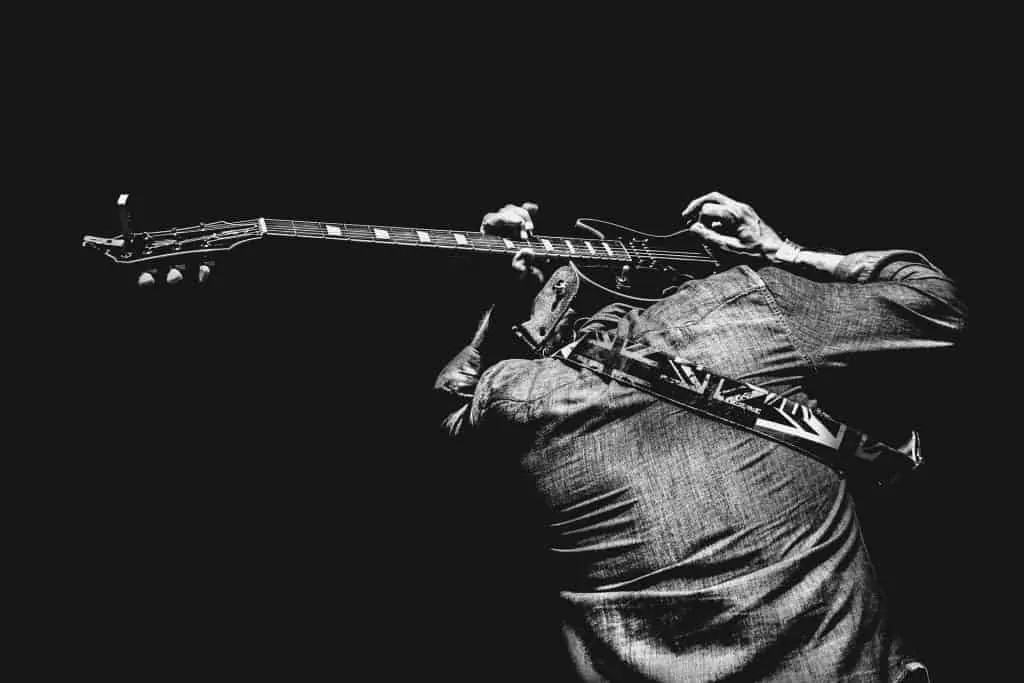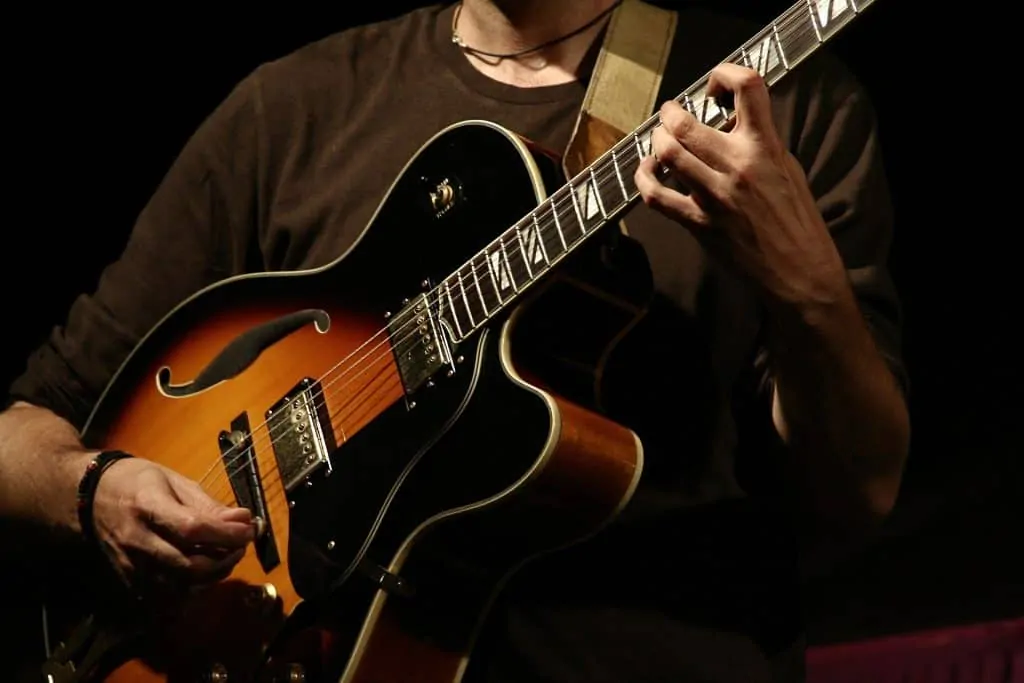Jam sessions are one of the best ways to improve your skills as a guitarist and have a great time playing with other musicians. However, the prospect of a jam session can feel imposing to many players.
From calling tunes to comping over other players’ songs and improvising solos, jam sessions are complex endeavors. Beginners may struggle to take everything in at first — or worse, feel left out and give up on the session entirely. This guide aims to explain everything you’ll need to know to shorten your learning curve and help you take full advantage of your next jam.
No matter the genre or style, many jam sessions involve long rhythmic vamps, individual solos, and collective, “traded solos” throughout the course of a tune.
Contents
Basics of Jam Sessions
First and foremost, no two jam sessions are the same. A variety of factors can influence the character of any particular jam, from the time and place to the genre of music and regular crowd of musicians. Even two different dates of a periodic organized jam may be significantly different.
The first takeaway from this is that you shouldn’t get easily discouraged by a bad jam. The next jam may be better. If it isn’t, chances are you can find other jam sessions around that may offer a much more enjoyable experience.
With that being said, most jams do tend to follow a similar structure, especially those at clubs, bars, or other music venues. Players will rotate on and off stage, and each one will generally get a chance to call a song to play.
Depending on the format, that song may be a popular hit, a jazz standard, a basic blues progression, or anything in between. While tune-callers are generally expected to give some tips on the basics of their song for those who don’t know, you may often need to keep rhythm off of their instructions alone, or play along with changes from a sheet in real time.
Soloing is an essential part of jamming — after all, part of the fun of playing with other people is showing off your skills! Protocol for soloing may vary from jam to jam; the size of the session or skill of those involved can dictate the soloists and order of solos. Most jams will structure the songs to allow multiple solos from those on the bandstand.
A good rule of thumb is that if you call a tune, you’ll be given space for a solo. If the jam rotates guitarists (as most do), you may be able to solo for each tune when you’re on stage. However, you’ll probably only get to play for two or three songs at a time, so it’s a definite trade-off!
Most jams tend to be inviting for newer and shyer players. If you would prefer to just play rhythm, you can let the other players know. Don’t be surprised, though, if they gently push you to give soloing a shot. Jams are a great way to improve your skills, and friendly encouragement is often the way to push a bit beyond your comfort zone.
Many guitarists find jam sessions through other local musicians or online musician’s groups.
How To Find Jam Sessions
Before you can play at a jam session, you’ve got to find one first! The easiest way is to do a quick Google search for jam sessions in your local area. Many bars or clubs may host weekly or semi-weekly jam nights in a variety of genres.
Local musicians are another great avenue to find jams. Check for any online groups (especially on Facebook). If you don’t see any, don’t be afraid to ask any musician friends or even take a trip to a local guitar store. Odds are any staff or musicians there will be happy to tell you if they know of any jams in the area.
Thankfully, your first jam session won’t involve an audience like this.
How to Prepare for a Jam Session
Before you go to a jam session, take a bit of time to prepare so you’re as relaxed as possible at the event.
Do some online research: look up the venue’s website, see if they have a dedicated page for jam information, get a feel for the style and character of the place. If there’s no information for the jam, you can try some musician’s forums or give the venue a call to ask a few questions.
Some jams will provide a backline for guitarists, meaning you only need to bring your instrument and plug into their amps, while others expect you to bring your own amplification as well. A quick Google search or phone call can save you from ending up with no amp to play through, so don’t forget this step!
You should also have a fair idea of the musical style before you show up to the jam session. If the website or sign-up page (if there is one) doesn’t give enough detail, do some more research! Videos from past jams or information from other players who attend could be helpful.
While you don’t need to show up with a full setlist in mind, it’s always a good idea to think of a few songs that you enjoy and can play, are simple to explain, and offer opportunities to solo.
Depending on the theme of the jam you could find a few jazz guitar standards or popular rock songs to suggest. Try to be original with your choices — no, “Smoke On The Water” or “Smells Like Teen Spirit” don’t count.
In any situation, a blues is a great backup plan. Whether you’re at a blues-focused session or someone just stole your song idea, calling a blues form is a simple and entertaining way to please everyone else on the bandstand. Switch up the key or move to a 16-bar form (rather than the standard 12) to keep things interesting, and avoid overplayed keys like E and A in particular.
Make sure that you can play smooth rhythm guitar without slowing others down! Before jamming, practice playing songs with just a chord sheet in front of you. Knowing your different chord shapes is essential for this skill.
If you have no idea of a song at the jam, you can always ask the person who called it for a quick explanation, but your goal should be to play through the session without stumbling or holding the whole band up. Thankfully, most songs will be popular enough or simple enough you should be able to “comp” (play rhythm) as you go without serious issues.
Preparation Essentials:
- Think of 3-5 potential songs to call
- Work on your rhythm playing
- Practice soloing over backing tracks
- Research the venue to determine the required equipment
A great example of communicating with other players while up on the bandstand.
What to Do At a Jam Session
When you arrive at the venue, take a few minutes to check in and talk with the other musicians there. It’s always helpful to get there early, as it gives you a bit of extra time to settle in, calm any nerves, and get ready to play when the jam begins.
If there’s a dedicated MC or organizer, don’t be afraid to introduce yourself. A little introduction will help him or her pair you on the bandstand with other musicians who share your skill level and interests.
Playing Tips For Jam Sessions
Once the jam session gets underway, the organizer or MC will typically direct traffic. At some sessions, there may be a house backing band that plays a distinct set then invites jammers up to join, or the jam may start out of the gate.
Calling Songs
At some point during your time on stage, you will be expected to call a song for everyone to play. If you’ve thought through some ideas before the jam, this shouldn’t be too difficult. Just make sure to explain the changes for everyone, and specify any tips about the structure or melody of the tune. If for example you just want to play the verses while people solo, remember to tell people when you call out the tune.
Make sure everyone is clear before you begin playing! Usually all it takes is a quick glance at each player for a thumbs-up or similar sign of approval, but be prepared to clarify any questions other players might have. Once you’re sure everyone’s ready to go, you can count in the song and get playing!
Rhythm playing is just as important as soloing at a jam. Finding partial chords higher on the neck is a great way to differentiate yourself from other guitarists also playing rhythm at the same time and add some character to any tune.
Playing Rhythm At a Jam
The fastest way to ingratiate yourself to other players at a jam session is to keep great rhythm. If that’s not reason enough to practice your rhythm guitar, nine times out of ten you’ll spend the majority of the jam playing rhythm anyway, so it’s something you might as well get used to beforehand.
In all seriousness, rhythm playing is an essential guitar skill to master. A steady, accurate rhythm part fuels a song and anchors the groove for soloists and other instrumental players.
It’s the tune caller’s responsibility to make sure you know the form and general chords to the song they call. If you’ve never heard the song or their explanation makes no sense, try to find a chord sheet to play from, or pick up the chords by ear as the tune progresses. If you really feel lost, you can always choose to take a rest for the tune — if you’re not confident you can make it through the form, this can be a great way to tune up your guitar, enjoy a quick drink, and simply take in the atmosphere before the next song.
When playing rhythm, the most important thing is keeping the initial tempo and locking down a steady pattern. As a guitar player, it can be especially hard to resist the urge to speed up or to over-embellish! Instead, follow the lead of the other musicians and keep things relaxed. Turn down your volume a bit when playing rhythm to give the soloists some space to shine.
Once you’ve locked into the groove and feel comfortable playing with the chord structure, don’t be afraid to add a few timely accents to liven up the beat. If multiple guitarists are playing rhythm parts, you can also find different chord voicings or play partial chords. A bit of creativity and coordination can take a tune from mediocre to rock-solid.
Just make sure you don’t overdo the accents, or sacrifice the groove to make your part busier. Jam sessions are all about cooperation. Be a team player and take extra care not to hog the limelight or ignore your job when you’re not soloing.
Jam Session Rhythm Tips:
- Focus on the groove, not the accents
- Stay on tempo
- Don’t step on other players’ toes (play different voicings)
- Make the soloist sound as good as possible!
Doing this during your solo may be the quickest way to not be invited back to the next jam.
Soloing
Soloing is the essence of any jam session. And while it may seem imposing for new players, with a few simple guidelines you should be able to deliver effective solos and keep up at any jam session.
If you’ve never practiced improvising a solo or wouldn’t feel comfortable soloing in any case at a jam session, don’t go just yet. Practice your scales (major, minor, pentatonic, modes, and arpeggios) through the circle of fifths and improvise some solos over backing tracks or with a looper pedal. Listen to some of your favorite solos and note what licks and techniques the players use to guide you. You can also check out our article on essential guitar improvisation techniques to help focus your practice in this area.
If you’re a more intermediate player with some soloing experience, keep practicing! Pentatonic soloing should work well for most jam-session songs. If it’s not a standard blues form, you can use major pentatonic to play over the chords of a given form. If the changes come fast in a particular section, focus on outlining the chords — that is, use the notes from the chord shape you played for rhythm to guide your improvisation.
For advanced players, focus on developing your improvisational vocabulary and delivering focused, articulate solos. Stay away from tapping and shredding (nobody likes a show-off) and strive for clear, tasty licks with feel. Your goal should be to improve your own playing and work on improvisational methods you’ve never used before, rather than showing up every other player at the jam. That advice is especially important if you want to be invited back to the next session.
No matter your skill level, you’ll need to keep a few logistical tips in mind when soloing. If you’ve called the tune, you’ll be expected to take the first solo, so be prepared! When going into your solo, turn your volume up a tad so you can be heard over the mix. Just don’t drown out the rhythm section and remember to turn back down when you’re finished.
A rule of thumb regarding solo length: every solo gets one chorus, a good one earns two, and only great ones get three choruses or more. In a jam session environment, everyone deserves an opportunity, but nobody should dominate. Keep your solos short and sweet! As you near the end of each chorus, look around the stage and communicate with the other musicians; if they encourage you to keep soloing, go for it! Otherwise, get ready to pass it off to the next soloist.
Jazz Session Soloing Tips:
- Prioritize feel and ideas over speed
- Outline chords over more difficult changes
- Keep your solos focused and communicate with other players
Remember to turn down your amp when trading fours so you don’t overpower the other guitarists!
“Trading Fours”
On certain tunes (especially at jazz jams), players will “trade fours” after each person has taken a solo. This means that multiple players will take turns delivering a four-bar lick and building off each other. The trade-off can go for one chorus or many, but the general idea remains the same.
The order of players will usually go based on the solo order from earlier in the song. Remember your place in line and the rest is pretty simple. Once again, just be considerate of other players — don’t cut in early or let your licks run a bar long — and you should be fine.
Conclusion
If you’ve never jammed before, jam sessions can feel imposing or out of your league. It’s easy to convince yourself that you’ll never understand the process or keep up with the musicians.
But with some common etiquette and a bit of practice, jam sessions can become a unique opportunity to improve your chops and enjoy making music with other people. We hope this guide has been helpful and given you all the tools you need to take advantage of your next local session. Enjoy the jam!
Jazz is one of the more popular genres at many jam sessions. Time to brush up on your extended chords!


